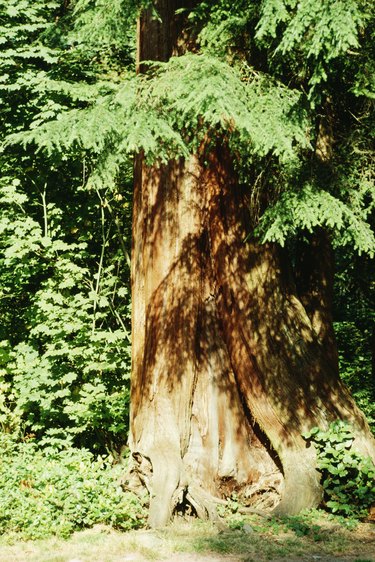
In the eastern regions of the United States, centuries-old wooden fences are still standing. However, the durable chestnut trees that provided this fencing material are no longer available. Today, wooden fence posts are constructed from a diverse array of wood species, including cedar, locust, redwood, oak, spruce, pine and fir. When selecting trees for fence posts, the "best" fence post for your needs is dependent on availability, price, ease of handling, strength and durability. Whether you are building a fence to enclose livestock, define property boundaries, create a windbreak or privacy screen or to enhance the beauty of your home landscape, a variety of tree species can provide the wood to satisfy your fencing requirements.
Cedar
Video of the Day
Cedar is one of the most ascetically pleasing materials for fence posts. Western red cedar and northern white cedar warp, cup and check less than other fencing woods. In Hawaii, the Gulf Coast states and the eastern seaboard, termites are the number one enemy of wooded fence posts. Termites living in wood piles, tree roots or wood debris can quickly attack wooden fences. Cedar is impregnated with natural oils and acids that make it undesirable to most insect pests. Cedar is porous and readily accepts a stain finish. Installed unfinished, cedar will last for decades, aging to an attractive shade of silver-gray.
Video of the Day
Locust
Depending on price and availability, locust may be your best choice when selecting wood to build a farm or ranch fence. Known for its incredible strength and durability, black locust wood is considered to be the most valued wood to construct split rail fences. Extremely heavy, strong, stiff and highly shock resistant, black locust wood is the preferred material for building horse paddocks and livestock pens. Newly harvested black locust wood has a yellowish-green tint that deepens over time to a rich golden yellow. Locust is resistant to termites, decay and wood rot. Locust wood split rail fence posts can be placed directly on the ground or on a layer of gravel. They are one of the easiest fences to install, requiring no wood treatment, staining or painting. Locust wood fence poles will last for 75 years or longer.
White Oak
White oak provides excellent fencing material, and is resistant to insect infestation and wood rot. When cutting or purchasing oak fencing material, be sure that you are selecting white oak and not red oak. Red oak is an inferior wood, unsuitable for fence posts. White oak is fairly inexpensive when compared with locust or cedar; however, you can build a solid fence that will last for 10 to 15 years. If economy is a consideration, white oak may be the "best" material for the job.
Whitewoods
Named for their color when newly cut, whitewoods include fir, spruce and pine. In the southeastern and Gulf coastal regions of the United States, yellow pine is the wood of choice. Douglas fir is commonly used in the Pacific Northwest. Both tree species are strong, straight trees that provide quality fence posts. You can cut and age your own posts or purchase pressure-treated whitewood posts from post and pole sawmills, lumberyards or do-it-yourself home and garden centers. When purchasing treated posts, look for the stamp, seal or other certification that the post has been treated to withstand termites and wood rot.
- University of Wisconsin Extension; Protecting Wooden Fences for Yard and Garden; Rodney C. De Groot, et al.; September 1979
- Pennsylvania State University Extension; Fencing Plan for Horses; Eileen Wheeler, et al.
- Oregon State University College of Forestry; Service Life of Treated and Untreated Fence Posts; Donald J. Miller; 1985
- Expert Fence: Cedar Versus Pressure Treated Pine